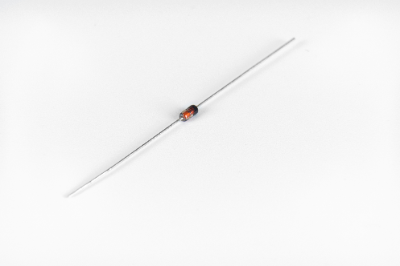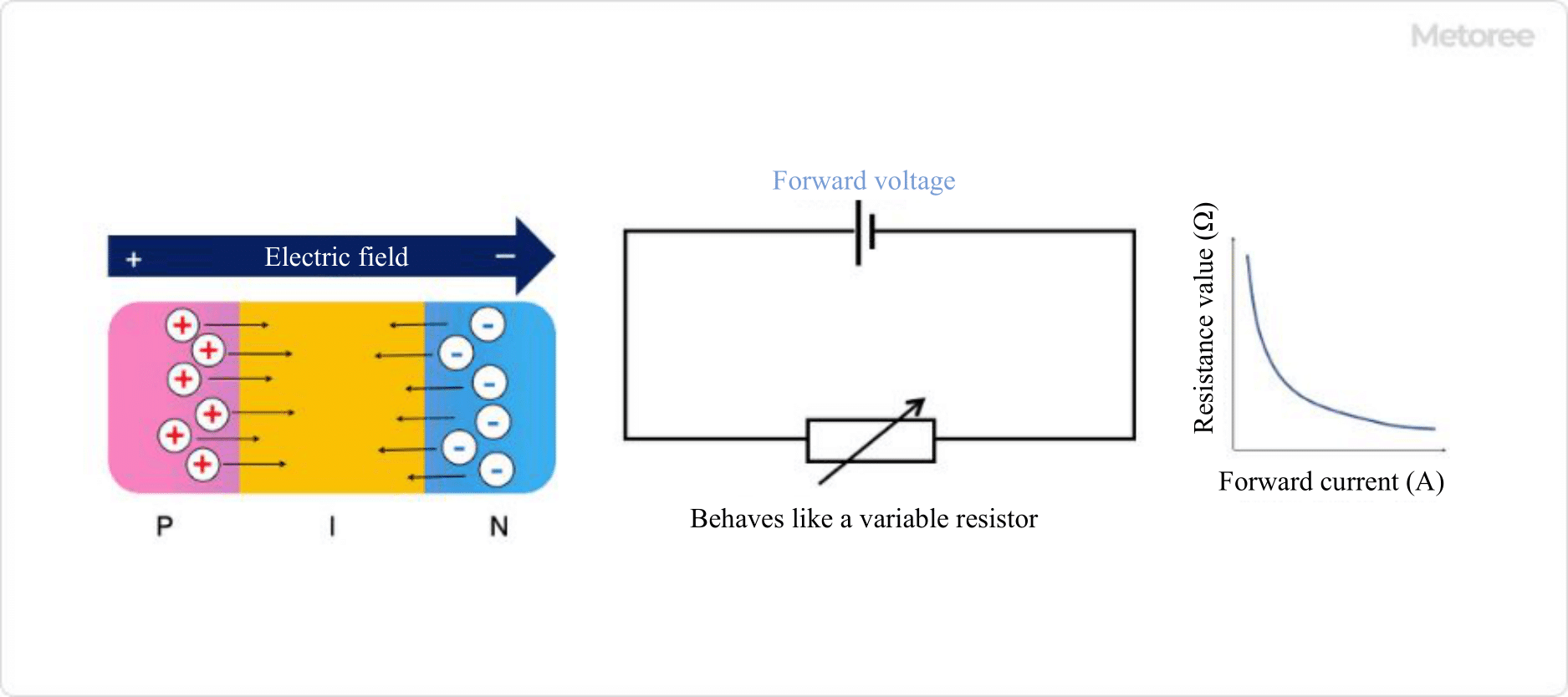All Categories
History









This section provides an overview for pin diodes as well as their applications and principles. Also, please take a look at the list of 9 pin diode manufacturers and their company rankings. Here are the top-ranked pin diode companies as of January, 2026: 1.Micro Commercial Components, 2.Massachusetts Bay Technologies, 3.ROHM Co., Ltd..
Table of Contents
Categories Related to PIN Diodes
 A PIN Diode is a diode with a true I-type semiconductor of high electrical resistance between the P-type and N-type semiconductors and a wide depletion layer.
A PIN Diode is a diode with a true I-type semiconductor of high electrical resistance between the P-type and N-type semiconductors and a wide depletion layer.
The wider depletion layer improves the response characteristics. The forward voltage is almost the same as that of a PN junction diode, and PIN Diodes are used as variable resistors, especially at high frequencies, because their resistance changes with the flowing current. They can also be used as capacitors when reverse voltage is applied.
PIN Diodes have low capacitance between terminals, low series resistance, and high frequency characteristics. Therefore, they are used for switching high-frequency signals such as those used in cellular phones, since they do not easily affect high-frequency communication lines. It is also used in band switching, AGC circuits, and receiving attenuators as a variable resistor because of its ability to change resistance in response to current. It also acts as a capacitor when a reverse voltage is applied.

Figure 1. Forward voltage applied to the PIN diode
When a forward voltage is applied to a PIN Diode, holes from the P-type semiconductor and electrons from the N-type semiconductor move into the I-type semiconductor, where they meet and recombine. The holes and electrons from the P-type and N-type semiconductors meet in the I-type semiconductor, resulting in a change in resistance. In other words, the resistance changes in response to voltage, making it possible to use the device as a variable resistance by controlling the voltage.
In addition, by changing the thickness and area of the depletion layer of the I-type semiconductor, the capacitance between terminals can be varied and the resistance characteristics can be selected Compared to PN-type semiconductors that do not have an I-type semiconductor, PIN Diodes have improved performance because they are more effective in accumulating carriers such as holes and electrons.

Figure 2. Reverse voltage applied to PIN diode
On the other hand, when a reverse voltage is applied, holes and electrons gather on the P-type and N-type surfaces respectively, and the I-type semiconductor becomes a dielectric and acts as a capacitor.
Conductivity modulation refers to the change in resistance due to the flow of carriers into the high-resistance layer when biased.
The I layer, sandwiched between the P and N layers, consists of elements with tetravalent valence, such as silicon (Si) and germanium (Ge). These are called true semiconductors because they are pure semiconductors containing no other elements. They are insulating layers in which electrons cannot move because they are bound by stable covalent bonds with eight electrons.
However, when forward biased in a PIN Diode, holes flow from the P layer and electrons flow from the N layer, and the I layer becomes highly doped. As a result, conductivity modulation occurs and the I layer, which had high resistance, becomes low on-resistance as current flows in the forward direction.
PIN Diodes are also used in high-frequency switches. While mechanical switches are also available in the low-frequency range, coaxial relays and semiconductor switches are used in the high-frequency range. In recent years, they are also used as millimeter-wave band MMIC switches due to the spread of LAN communication systems and in-vehicle radar systems.
The principle of PIN Diode switch circuits is that high-frequency signals are output during forward bias and no high-frequency signals are output during reverse bias. Both reflective and absorptive types exist in the product lineup. Reflective switches transmit high-frequency power during reverse bias and reflect it during forward bias. Absorptive switches have a low voltage standing wave ratio (VSWR) and low signal loss in both ON and OFF modes.
In general, PIN Diode switches are superior in terms of switching speed and small size, but they have the disadvantage of high power consumption.
The reason for the large power consumption is the need to apply a high bias to minimize insertion loss. To compensate for this disadvantage, an optical switch called MEMS (Micro Electro Mechanical System) has been developed for the millimeter wave band and is gaining market share in today's market.
*Including some distributors, etc.
Sort by Features
Sort by Area

MCC is a manufacturer of semiconductors, founded in 1991, and has its headquarters located in California, USA. Their portfolio contains five core semiconductor types—offering a full range of diodes, rectifiers, transistors, MOSFETs, voltage regulators, and protection devices. Their products are used to optimize power management, enable signal processing, protect circuits, and enhance the performance of electronic systems across various sectors such as consumer electronics, aerospace, medical devices, and more. The company has received IATF 16949:2016 and ISO 9001:2015 certifications.

Vishay Intertechnology, Inc. (Vishay) was incorporated in 1962 and is headquartered in Malvern, Pennsylvania. The company serves the industrial, automotive, telecommunications, consumer products, and medical end markets and sells its products under numerous brand names inlcuding Siliconix, Draloric, Beyschlag, UltraSource, and Applied Thin-Film Products. The company manufactures and sells discrete semiconductors and passive electronic components in globally while operating in six market segments: MOSFETs, diodes, optoelectronic components, resistors, inductors, and capacitors.

Semigen, established in 2009, and based in New Hampshire, USA, is a manufacturer and supplier of semiconductors. The product portfolio includes a diverse range of attenuators, capacitors, couplers, surmount, filters, inductor coils, resistors, transmission lines, diodes, and barrier quads. The company also offers products with quality test and foundry with value-added services, design, repair, and supply solutions. The products are used in various industries which include military, aerospace, satcom, wireless, communication, medical, and industrial sectors.

Microsemi Corporation was founded in 1959 and is headquartered in Aliso Viejo, California. Microsemi is a subsidiary of Microchip Technology Incorporated. Microsemi is a provider of semiconductor and system solutions for aerospace, communications, data center, and industrial markets. A few of Microsemi’s product lines include high-performance and radiation-hardened analog mixed-signal integrated circuits, FPGAs, power management products, timing and synchronization devices, and RF solutions. Microsemi’s technological strengths are in connectivity, energy efficiency, miniaturization, power management, and security.

Massachusetts Bay Technologies, established in 1999, and based in Stoughton, Massachusetts is a manufacturer and supplier of semiconductors and capacitors. The product portfolio includes diverse range of microwave silicon diodes, ceramic capacitors, and thin film products. The products are used in different types of industries such as academic, university, and laboratory research, consumer products, telecom, military, and space. The company offers ISO-certified products with high-reliability systems, design development, product performance, and quality control.

Pasternack headquartered in Irvine, California, is part of the Infinite Electronics family of brands, established in 1972 by Murray Pasternack, as a supplier of RF and Microwave components. The company retails various types of products, including connectors, switches, cables, couplers, and filters. They have over 40,000 in-stock products and have partnered with 19 international distributors serving customers in over 35 countries. The company offers contract assembling, where they assemble custom Cables for same-day shipping. The company earned the ISO 9001 certification in 2015 and offers expert technical support and 24/7 customer service.

Hamamatsu Photonics K.K., established in 1953 and headquartered in Hamamatsu, Japan, is a manufacturer of sensors and emitters for both visible and invisible light. It stocks products like LEDs, lamps, and photodiodes used in several industries, including consumer electronics, dental imaging, and environmental monitoring. The sensor and light source components are also available as modules and units that can be incorporated into systems the company develops, like optical measurement systems or imaging systems. The ISO 9001-certified company stocks over 15,000 devices, units, and systems that ship to over 100 destinations worldwide, and it has ten research and production bases.

NXP was established in 2006 as a spinoff from Phillips and is headquartered in Eindhoven, Netherlands. The company is a co-founder of NFC communication and designs and manufactures semiconductors that serve the automotive, industrial, mobile, and smart home industries. The company’s automotive products include driver assistance transceivers, sensors, and security systems. For industrial markets, the company produces RFID readers, processors, and microcontrollers. For communication infrastructure, the company produces RF mixers, diodes, and low-noise amplifiers for wireless LAN networks. The company also produces peripherals, power management chips, communications chips, and interface devices.

ROHM Semiconductor was incorporated in 1940 and is headquartered in Kyoto, Japan. ROHM manufactures and sells electronic components worldwide. ROHM operates through the segments ICs, discrete semiconductor devices, and modules. ROHM provides ICs comprising memory, amplifiers and linear, power management, clocks and timers, switches and multiplexers, logic, data converters, sensors and MEMS, display drivers, motor/actuator drivers, interfaces, communication and speech synthesis LSI, audio and video, and microcontrollers. ROHM also offers discrete semiconductor products include MOSFETs, bipolar transistors, and diodes; power devices, including power transistors and diodes, SiC power devices, IGBT, and IPM; passive devices, such as resistors, and conductive polymer and tantalum capacitors; and various modules among others.
Ranking as of January 2026
Derivation Method| Rank | Company | Click Share |
|---|---|---|
| 1 | Micro Commercial Components |
18.2%
|
| 2 | Massachusetts Bay Technologies |
14.9%
|
| 3 | ROHM Co., Ltd. |
12.8%
|
| 4 | NXP Semiconductors |
11.5%
|
| 5 | SemiGen |
11.5%
|
| 6 | Vishay Intertechnology, Inc., |
10.8%
|
| 7 | Microsemi Corporation |
9.5%
|
| 8 | Pasternack |
7.4%
|
| 9 | Hamamatsu Photonics K.K. |
3.4%
|
Derivation Method
The ranking is calculated based on the click share within the pin diode page as of January 2026. Click share is defined as the total number of clicks for all companies during the period divided by the number of clicks for each company.Number of Employees
Newly Established Company
Company with a History
*Including some distributors, etc.
*Including some distributors, etc.
| Country | Number of Companies | Share (%) |
|---|---|---|
 United States of America
United States of America
|
6 | 66.7% |
 Japan
Japan
|
2 | 22.2% |
 Netherlands
Netherlands
|
1 | 11.1% |
21 products found
21 products
Lightec Co., Ltd.
640+ people viewing
■Applications Transmitting/receiving antenna switching circuit for various communication equipment ■Summary L8104A-240 is a PIN diode designed for...
Lightec Co., Ltd.
740+ people viewing
Last viewed: 15 hours ago
■Applications Antenna switch for portable radio equipment for VHF/UHF band ■Summary L5208F is a PIN diode designed for high frequency power switch...
Lightec Co., Ltd.
590+ people viewing
Last viewed: 15 hours ago
■About Lightec's PIN diode Our PIN diodes are silicon PIN diodes that are indispensable for amateur and professional wireless communication equipme...
Lightec Co., Ltd.
500+ people viewing
Last viewed: 1 day ago
■About Lightec's PIN diode Our PIN diodes are silicon PIN diodes that are indispensable for amateur and professional wireless communication equipme...
Opto Techno Co., Ltd.
730+ people viewing
Last viewed: 29 minutes ago
■Photodiode for optical communication - Cutoff frequency is 100MHz. ・The maximum sensitivity wavelength of spectral characteristics is 880nm. ・Ef...
Keisei Co., Ltd.
380+ people viewing
Last viewed: 15 hours ago
■Features ・Small mold type ・High reliability
Towa Electronics Co., Ltd.
520+ people viewing
Last viewed: 1 hour ago
This is a diode whose capacitance value is variable depending on the value of reverse bias voltage. Mainly used in high frequency matching circuits...
Towa Electronics Co., Ltd.
480+ people viewing
Last viewed: 1 day ago
Used as a switch for high frequency signals. Ideal for switching frequency bands between UHF/VHF bands in TV tuners. ■Product overview RoHS Compat...
Nisshinbo Micro Devices Inc.
500+ people viewing
Last viewed: 1 day ago
NJL6402R-2 is a high-speed PIN photodiode developed for front laser power monitoring of optical pickups that supports 3 wavelengths. Achieves low w...